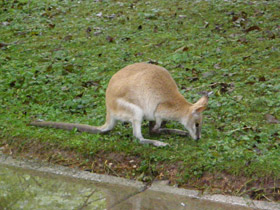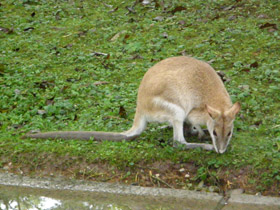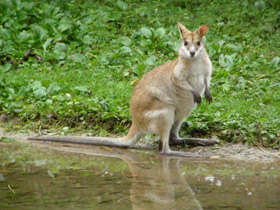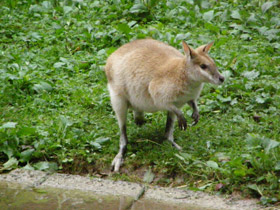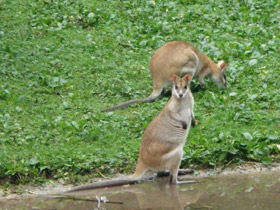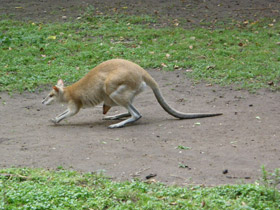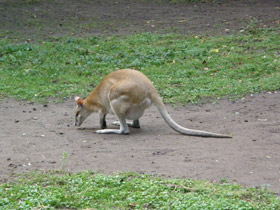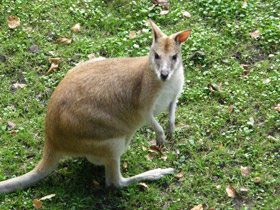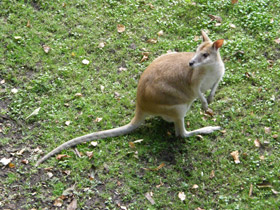The agile wallaby or the sandy wallaby (Notamacropus agilis or Macropus agilis)
The agile wallaby (Notamacropus agilis or Macropus agilis), also known as the sandy wallaby, is a species of wallaby found in northern Australia and southern New Guinea. It is the most common wallaby in north Australia. The agile wallaby is a sandy colour, becoming paler below. It is sometimes solitary and at other times sociable and grazes on grasses and other plants. The agile wallaby is not considered threatened.
Subspecies
The four subspecies of the agile wallaby are:
- Notamacropus agilis agilis, the nominate subspecies, is found in the Northern Territory.
- Notamacropus agilis jardinii is found on the northern and eastern coasts of Queensland.
- Notamacropus agilis nigrescens is found in the Kimberley and Arnhem Land regions of Western Australia.
- Notamacropus agilis papuanus is found in southern New Guinea and some neighbouring islands.
Habitat and appearance
Macropus agilis or Notamacropus agilis is a species of diprotodontid mammal in the family Macropodidae. It is found in Australia (north-eastern Western Australia, Northern Territory and Queensland), southern New Guinea and the islands of Entrecasteaux and Trobriand.
Macropus agilis is common in most of northern Australia and New Guinea, in New Guinea in grasslands and lowland savannahs and in Australia along rivers and streams in open woodlands, grasslands and coastal dunes.
Macropus agilis has a body length of 60-105 cm and a tail of about 75 cm, and males weigh up to 20 kg and females up to 12 kg.
Nutrition
Macropus agilis feeds on grasses, fruits and leaves, but also on roots, bark and other plant parts in dry areas. If it rains sufficiently and the vegetation remains succulent, wallabies do not need any additional liquid. They also absorb the morning dew from their food, so these marsupials rarely drink.
Lifestyle
Macropus agilis is active mainly at night and in the morning or evening, when the heat decreases; during the day they rest in holes they have dug, licking their forearms. This behaviour is characteristic of many kangaroo species and helps them to cool their bodies, which they do by evaporating saliva. Even when resting, Macropus agilis are always on the lookout; they are very skittish and warn each other of danger with a peculiar drumming sound they make with their hindquarters.
Social behaviour and reproduction
Macropus agilis lives in groups of 10 or more individuals, with a leader. Sometimes several groups join together to form large herds in pastures. Reproduction of these marsupials can occur throughout the year, but births are most frequent between May and August. After a gestation period of 29 days, the female gives birth to a single calf. It spends the first 6-7 months in its mother's pouch and then leaves it, but does not become independent until one year of age. Females are sexually mature by then, while males reach sexual maturity after another two months.
Status
The agile wallaby has a wide range and is common over much of that range. It faces no major threats; however, in New Guinea it is shot for bushmeat and in Australia it is sometimes killed by farmers as a pest. It is present in a number of protected areas in Australia, but this is not the case in New Guinea. Overall, the population is thought to be declining, but the total population is large and the rate of decline is slow, so the IUCN considers this species to be of least concern.
In Western Province, Papua New Guinea, agile wallabies are hunted by local indigenous peoples using fire drives.
In Aboriginal language and culture
In the Bininj Kunwok language the male agile wallaby is known as warradjangkal, and the female as merlbbe. According to Kunwinjku elder Peterson Nganjmirra, the "small one" (joey) is known as njip.

















